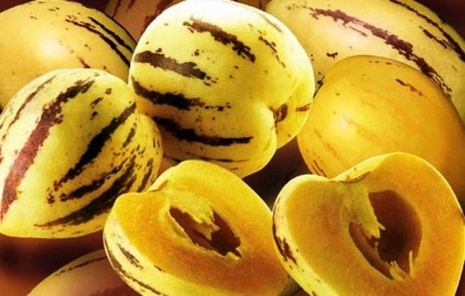Due to its diverse array of natural environments, Peruvian Fruits boast an astonishing variety of edible treasures that are (literally) ripe for the picking. Here we’ve selected twenty of the country’s most distinctive fruits. Some of these are consumed regularly throughout the world, while others are still mostly known only in their native lands. How many have YOU tasted?
Official websites
This wetland fruit is favored by dieters for its supposed slimming properties. Aguajes have a thick texture and a mild, dry flavor which can be used in ice cream and other frozen desserts.
Despite its tart, cherry-like flavor, this small, orange fruit is actually most closely related to the tomatillo. It is exceptionally low in calories and contains several important nutrients such as thiamin, niacin and vitamin C.
Cacao is, of course, best known for its bitter, dark beans which are used to create chocolate. However, many people don’t realize that these pods also contain a fleshy white pulp with a pleasant sweet and sour flavor.
Grown on bushes in the Amazon, these reddish purple berries are famous for containing the highest concentration of vitamin C of any known food source on Earth.
A type of cherry, the capulin is a juicy, aromatic fruit with a slight tartness which is often turned into jam or enjoyed as an ingredient in various desserts. It has also been used in syrup form as a way to treat respiratory problems.
Also known as a custard apple, this creamy tropical fruit was once referred to as “the most delicious fruit known to man” by writer Mark Twain. In addition to this deliciously sweet taste, the chirimoya also has plenty of vitamins, nutrients and antioxidants, making it one of Peru’s healthiest snacks as well.
Closely related to the naranjilla, this red, yellow or purple fruit grows on tropical shrubs in the Amazon region. Its flavor has been described as a cross between a tomato and a lemon.
Also known as the sweet passionfruit, this tasty Andean fruit is similar to its more famous cousin, but with a sweeter, less acidic flavor. Well-known in Peru for its positive effects on the digestive system, the granadilla is a great source of fiber, calcium and several essential vitamins.
A popular ingredient in tropical drinks and smoothies, the guanábana, or soursop, has been used as an alternative treatment for cancer for decades. Its flavor is complex, with notes of pineapple, strawberry and citrus fruits.
Common in tropical regions throughout the world, guavas are great for making juices and jams, as well as eating raw. Though they can come in many different shapes and colors, Peruvian guavas are typically green with pink flesh.
An essential ingredient for chefs and bartenders, Peruvian limes are intensely sour compared to the limes found in other countries. We recommend a pisco sour or lemonade for a balanced and refreshing way to taste these citrus fruits.
One of the most popular fruits in Peru, the lúcuma is a common flavor in ice cream and many other sweets. The eggfruit, as it is known in English, is a subtropical fruit of the Andes valleys with bright yellow flesh whose flavor is slightly reminiscent of the sweet potato.
Peru is one of the largest exporters of these popular fruits in the world. Though mangoes can come in many different varieties, the most common ones have reddish skin with orange pulp. They are a cheap and readily available snack across most of South America.
The inside of the passionfruit (the English name for maracuyá) is scraped out, strained and sometimes diluted with water in order to produce passionfruit juice. This distinctly sour nectar is an extremely common ingredient in both alcoholic and nonalcoholic drinks, as well as in various desserts.
Also known as the ice-cream bean, this strange legume native to the Andes valleys contains a sweet edible pulp with a flavor reminiscent of vanilla ice cream.
A type of melon, this mild fruit is similar to cantaloupe and is usually eaten by itself or paired with other fruits in a fruit salad.

Commonly known as “dragon fruit” in English, the pitahaya is a sweet fruit produced by a type of night-blooming cactus. It comes in several different colors and has a texture which is often compared to the kiwifruit due to its seeds.
One of the few elderberry species which can be eaten uncooked, saúco is typically eaten as fresh fruit but is also commonly used in jams and wines.
Also known as a “banana passionfruit,” this Andean valley fruit is similar to the granadilla with its viscous interior and edible seeds. Much like its cousin, it is usually eaten fresh as a snack but also makes a great addition to cocktails, juices and jams.
Known in English as a “prickly pear,” tuna is the edible fruit of the Indian fig cactus. These lowland specialties are great for making jam, cocktails, or just eating on their own.
As you can see, this country is blessed with a multitude of delicious and unique fruits. Of course, the only way to sample all of these wonderful snacks in their natural habitat is to make a once-in-a-lifetime trip to Peru. If you’d like to plan a trip, we highly recommend checking out findlocaltrips.com, a tour comparison website with tons of info on tours and activities in every region of Peru as well as other countries in South America.